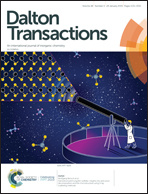Theoretical insight into the electrocatalytic reduction of CO2 with different metal ratios and reaction mechanisms on palladium–copper alloys†
Abstract
Environmental impacts of continued CO2 production have led to an increased need for new methods of CO2 removal and energy development. Electrochemical reduction of CO2 has been shown to be a good method through recent studies. Alloys are of special interest for these applications, because of their unique chemical and physical properties that allow for highly active surfaces. Here, PdnCum (m + n = 15 and n > m) bimetallic electrocatalysts were used for systematic studies to understand the effect of the composition of Pd and Cu on the electrochemical reduction of CO2 to CO. In particular, the Pd–Cu alloy with the Pd/Cu = 2/1 atomic ratio (i.e., Pd10Cu5) has the best catalytic effect, particularly true at the step of the hydrogenation of CO2 to COOH, and the Pd10Cu5 catalyst is better than most known electrodes. With the energetic analysis of the proposed reaction pathways over the Pd10Cu5 catalyst, the limiting voltages for CO2 reduction to CH3OH, CH4, and CH3CH2O have been compared. Most importantly, the kinetic model analysis showed that the rate constant values indicate that the probability of generating C2H5OH on the Pd10Cu5 catalyst is greater than that of CH3OH or CH4. The findings revealed in this study may shed some light on the design of cost-effective and efficient electrocatalysts for CO2 conversion to CO or to other useful hydrocarbons.



 Please wait while we load your content...
Please wait while we load your content...